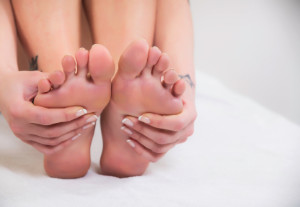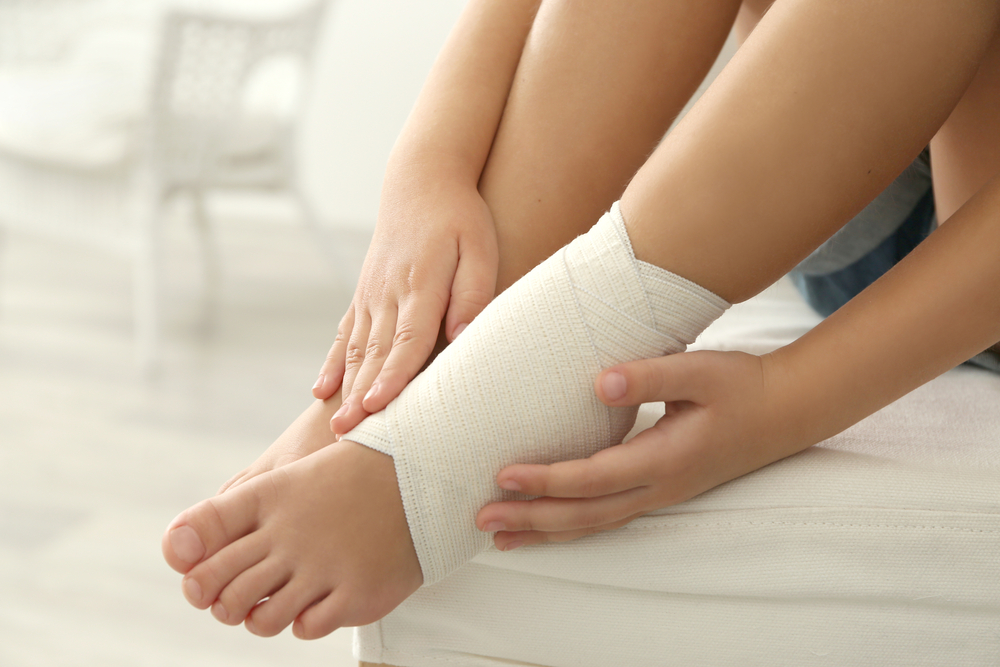Items filtered by date: December 2020
What Is a Tailor’s Bunion?
 A Tailor’s bunion, sometimes called a bunionette, is similar to a regular bunion. However, a Tailor’s bunion forms on the 5th metatarsophalangeal joint (or the “pinky toe”) instead of the big toe. Tailor’s bunions are most commonly caused by poorly fitting footwear, as well as structural foot problems. They appear as a swollen and hard bump on the outside of the foot next to the big toe, and they generally form over a long period of time and may not become painful for a while. Treatment options that a podiatrist may suggest include surgically removing the bunion, a corticosteroid injection to reduce swelling, and padding or orthotics to reduce pain. If you are dealing with pain that may be a Tailor’s bunion, be sure to consult with a podiatrist for a proper diagnosis and treatment.
A Tailor’s bunion, sometimes called a bunionette, is similar to a regular bunion. However, a Tailor’s bunion forms on the 5th metatarsophalangeal joint (or the “pinky toe”) instead of the big toe. Tailor’s bunions are most commonly caused by poorly fitting footwear, as well as structural foot problems. They appear as a swollen and hard bump on the outside of the foot next to the big toe, and they generally form over a long period of time and may not become painful for a while. Treatment options that a podiatrist may suggest include surgically removing the bunion, a corticosteroid injection to reduce swelling, and padding or orthotics to reduce pain. If you are dealing with pain that may be a Tailor’s bunion, be sure to consult with a podiatrist for a proper diagnosis and treatment.
If you are suffering from bunions, contact Leonora Fihman, DPM of California. Our doctor can provide the care you need to keep you pain-free and on your feet.
What Is a Bunion?
A bunion is formed of swollen tissue or an enlargement of boney growth, usually located at the base joint of the toe that connects to the foot. The swelling occurs due to the bones in the big toe shifting inward, which impacts the other toes of the foot. This causes the area around the base of the big toe to become inflamed and painful.
Why Do Bunions Form?
Genetics – Susceptibility to bunions are often hereditary
Stress on the feet – Poorly fitted and uncomfortable footwear that places stress on feet, such as heels, can worsen existing bunions
How Are Bunions Diagnosed?
Doctors often perform two tests – blood tests and x-rays – when trying to diagnose bunions, especially in the early stages of development. Blood tests help determine if the foot pain is being caused by something else, such as arthritis, while x-rays provide a clear picture of your bone structure to your doctor.
How Are Bunions Treated?
- Refrain from wearing heels or similar shoes that cause discomfort
- Select wider shoes that can provide more comfort and reduce pain
- Anti-inflammatory and pain management drugs
- Orthotics or foot inserts
- Surgery
If you have any questions, please feel free to contact our offices located in Encino and Brentwood, Los Angeles, CA . We offer the newest diagnostic and treatment technologies for all your foot care needs.
What Can Cause Ankle Swelling?
Swelling in the ankles can be caused by conditions that specifically affect the ankle or by systemic conditions that affect the whole body. Often, the cause of swelling in an ankle is an injury, such as a strain or a sprain. Strains are the result of overstretched muscles or tendons in the affected area, whereas sprains occur when the ligaments in the ankle are overstretched or torn. Diseases of the joints, such as arthritis, can also lead to swelling in the feet or ankles. Pregnancy and obesity may lead to swelling in the ankles due to fluid retention and poor circulation. Treatment for swollen ankles will depend on what is causing the swelling. For more information, please consult with a podiatrist.
When dealing with systemic disease of the feet, it is extremely important to check the affected areas routinely so that any additional problems are caught quickly. If you have any concerns about your feet and ankles contact Leonora Fihman, DPM from California. Our doctor will assist you with all of your podiatric needs.
Systemic Diseases of the Feet
Systemic diseases affect the whole body, and symptoms usually are displayed in the feet. This condition can make a patient’s ability to walk unbearable. Systemic diseases include gout, diabetes mellitus, neurological disorders, and arthritis.
Gout – is caused by an excess of uric acid in the body. Common symptoms include pain, inflammation, and redness at the metatarsal/phalangeal joint of the base big toe. Gout can be treated by NSAIDs to relieve pain and inflammation, and other drugs that lower the acid levels in the body.
Diabetes mellitus – is an increase in the level of blood sugar that the body cannot counteract with its own insulin. Failure to produce enough insulin is a factor in Diabetes.
Diabetes of the Feet
Diabetic Neuropathy – may lead to damaged nerves and affect the feet through numbness and loss of sensation.
Peripheral Vascular Disease – can restrict the blood flow to the feet, and often times lead to amputation of the feet.
If you have any questions please feel free to contact our offices located in Encino and Brentwood, Los Angeles, CA . We offer the newest diagnostic and treatment technologies for all your foot and ankle needs.
Toenail Fungus Treatments
A fungal infection of the toenails can be unsightly. Infected toenails may have white or yellow patches of discoloration, be chalky, or have a crumbly texture. In more severe infections, the toenails may thicken and become deformed and discolored. There are several treatments available for toenail fungus. A podiatrist may prescribe oral antifungal medications, which have to be taken for several months to get full results. Topical treatments, such as medicated nail polishes, are applied directly to the affected nails and can also help treat toenail fungus. Sometimes, both treatments can be used simultaneously. For more information about treatment for toenail fungus, please consult with a podiatrist.
If left untreated, toenail fungus may spread to other toenails, skin, or even fingernails. If you suspect you have toenail fungus it is important to seek treatment right away. For more information about treatment, contact Leonora Fihman, DPM of California. Our doctor can provide the care you need to keep you pain-free and on your feet.
Symptoms
- Warped or oddly shaped nails
- Yellowish nails
- Loose/separated nail
- Buildup of bits and pieces of nail fragments under the nail
- Brittle, broken, thickened nail
Treatment
If self-care strategies and over-the-counter medications does not help your fungus, your podiatrist may give you a prescription drug instead. Even if you find relief from your toenail fungus symptoms, you may experience a repeat infection in the future.
Prevention
In order to prevent getting toenail fungus in the future, you should always make sure to wash your feet with soap and water. After washing, it is important to dry your feet thoroughly especially in between the toes. When trimming your toenails, be sure to trim straight across instead of in a rounded shape. It is crucial not to cover up discolored nails with nail polish because that will prevent your nail from being able to “breathe”.
In some cases, surgical procedure may be needed to remove the toenail fungus. Consult with your podiatrist about the best treatment options for your case of toenail fungus.
If you have any questions, please feel free to contact our offices located in Encino and Brentwood, Los Angeles, CA . We offer the newest diagnostic and treatment technologies for all your foot care needs.
Can Foot Stretches Ease Plantar Fasciitis Pain?
 The plantar fascia is located at the bottom of the foot and it connects the heel to the toes. It is a portion of tissue that is responsible for various foot functions. Many patients feel pain in the heel when the plantar fascia becomes inflamed, and stretching the affected foot may be an option for mild relief. It is beneficial to stretch the calves. This can be done by standing against a wall and placing one foot behind the other. Slowly bend the back leg until a gentle stretch is felt, and then repeat with the other leg. Additionally, the foot may feel better when it is rolled on a tennis ball, and this is helpful for stretching the arch. If you would like more information about the benefits of stretching the feet, please consult with a podiatrist.
The plantar fascia is located at the bottom of the foot and it connects the heel to the toes. It is a portion of tissue that is responsible for various foot functions. Many patients feel pain in the heel when the plantar fascia becomes inflamed, and stretching the affected foot may be an option for mild relief. It is beneficial to stretch the calves. This can be done by standing against a wall and placing one foot behind the other. Slowly bend the back leg until a gentle stretch is felt, and then repeat with the other leg. Additionally, the foot may feel better when it is rolled on a tennis ball, and this is helpful for stretching the arch. If you would like more information about the benefits of stretching the feet, please consult with a podiatrist.
Stretching the feet is a great way to prevent injuries. If you have any concerns with your feet consult with Leonora Fihman, DPM from California. Our doctor will assess your condition and provide you with quality foot and ankle treatment.
Stretching the Feet
Stretching the muscles in the foot is an important part in any physical activity. Feet that are tight can lead to less flexibility and make you more prone to injury. One of the most common forms of foot pain, plantar fasciitis, can be stretched out to help ease the pain. Stretching can not only ease pain from plantar fasciitis but also prevent it as well. However, it is important to see a podiatrist first if stretching is right for you. Podiatrists can also recommend other ways to stretch your feet. Once you know whether stretching is right for you, here are some excellent stretches you can do.
- Using a foam roller or any cylindrical object (a water bottle or soda can will do), roll the object under your foot back and forth. You should also exert pressure on the object. Be sure to do this to both feet for a minute. Do this exercise three times each.
- Similar to the previous one, take a ball, such as a tennis ball, and roll it under your foot while seated and exert pressure on it.
- Grab a resistance band or towel and take a seat. If you are using a towel, fold it length wise. Next put either one between the ball of your foot and heel and pull with both hands on each side towards you. Hold this for 15 seconds and then switch feet. Do this three times for each foot.
- Finally hold your big toe while crossing one leg over the other. Pull the toe towards you and hold for 15 seconds. Once again do this three times per foot.
It is best to go easy when first stretching your foot and work your way up. If your foot starts hurting, stop exercising and ice and rest the foot. It is advised to then see a podiatrist for help.
If you have any questions, please feel free to contact our offices located in Encino and Brentwood, Los Angeles, CA . We offer the newest diagnostic and treatment technologies for all your foot care needs.



